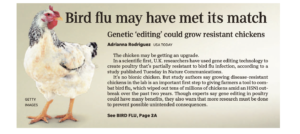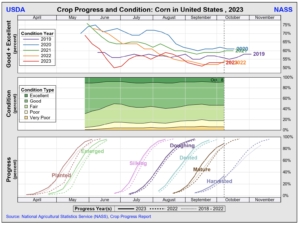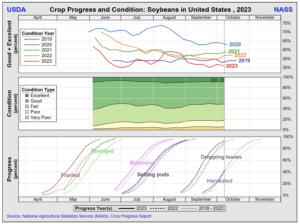Bloomberg's Tarso Veloso and Kim Chipman reported Monday that "agriculture giants including Cargill Inc. and Bunge Global SA are slowing their buying of soybeans due to uncertainty over US biofuels…
Scientists Use CRISPR Gene Editing To Combat Bird Flu; as Corn, Soybean Harvest Ahead of Average
Emily Anthes reported on the front page of today’s New York Times that, “Scientists have used the gene-editing technology known as CRISPR to create chickens that have some resistance to avian influenza, according to a new study that was published in the journal Nature Communications on Tuesday.

“The study suggests that genetic engineering could potentially be one tool for reducing the toll of bird flu, a group of viruses that pose grave dangers to both animals and humans. But the study also highlights the limitations and potential risks of the approach, scientists said.
“Some breakthrough infections still occurred, especially when gene-edited chickens were exposed to very high doses of the virus, the researchers found. And when the scientists edited just one chicken gene, the virus quickly adapted. The findings suggest that creating flu-resistant chickens will require editing multiple genes and that scientists will need to proceed carefully to avoid driving further evolution of the virus, the study’s authors said.”
Today’s article explained that, “Many nations have tried to stamp out the virus by increasing biosecurity on farms, quarantining infected premises and culling infected flocks. But the virus has become so widespread in wild birds that it has proved impossible to contain, and some nations have begun vaccinating poultry, although that endeavor presents some logistic and economic challenges.
“If scientists could engineer resistance into chickens, farmers would not need to routinely vaccinate new batches of birds. Gene editing ‘promises a new way to make permanent changes in the disease resistance of an animal,’ Mike McGrew, an embryologist at the University of Edinburgh’s Roslin Institute and an author of the new study, said at the briefing. ‘This can be passed down through all the gene-edited animals, to all the offspring.'”
Anthes pointed out that, “CRISPR, the gene-editing technology used in the study, is a molecular tool that allows scientists to make targeted edits in DNA, changing the genetic code at a precise point in the genome. In the new study, the researchers used this approach to tweak a chicken gene that codes for a protein known as ANP32A, which the flu virus hijacks to copy itself. The tweaks were designed to prevent the virus from binding to the protein — and therefore keep it from replicating inside chickens.”

And Adrianna Rodriguez reported on the front page of today’s USA TODAY that, “In a scientific first, U.K. researchers have used gene editing technology to create poultry that’s partially resistant to bird flu infection, according to a study published Tuesday in Nature Communications.”
“In theory, study authors say, gene editing should protect against any type of flu strain, prevent infection and eradicate transmission among domesticated chickens,” today’s article said.
Rodriguez added that, “There’s more work to be done before flu-resistant chickens become a viable option for farmers.
“One reason is that study authors tested a common but a less pathogenic bird flu strain, H9N2, not the H5N1 strain that wreaked havoc in birds around the world. Researchers said in last week’s briefing the latest strain was tested on new cells in the lab and had favorable results, but they have yet to infect the highly transmissible strain into chickens.”
Meanwhile, USA TODAY writers Dominik Dausch and Vanessa Arredondo reported today that, “The U.S. Department of Agriculture detected traces of highly pathogenic bird flu in commercial poultry flocks in South Dakota and Utah on Friday, raising concerns about possible future outbreaks across the country.”
The article noted that, “‘I don’t doubt that we will have more cases,’ South Dakota State Veterinarian Beth Thompson told The Associated Press. ‘I would be very pleasantly surprised if we’re done because migration is just starting.’
“Two days later, officials identified another infected commercial flock of 134,200 turkeys in Sanpete County, Utah.”
“The recent outbreak has cost the industry roughly $3 billion as farmers incurred additional costs and lost money when they didn’t have any birds on their farms,” the USA TODAY article said.

Elsewhere, DTN Managing Editor Anthony Greder reported yesterday that, “Despite being slightly behind average in some Eastern Corn Belt states such as Indiana and Ohio, this year’s corn and soybean harvests continued to outpace the five-year averages nationally last week, according to USDA NASS’ weekly Crop Progress report on Tuesday.”
The DTN article explained that, “Corn harvest moved ahead 11 percentage points last week to reach 34% complete as of Sunday. That is 5 percentage points ahead of 29% last year and 3 percentage points ahead of 31% for the five-year average. ‘Eastern states of Indiana and Ohio are below their usual paces, but the rest of the Corn Belt is mostly near or above its five-year averages for this time of year,’ said DTN Lead Analyst Todd Hultman.”

Greder added that, “Soybean harvest jumped 20 percentage points last week to reach 43% complete as of Sunday. That is 2 points ahead of last year’s 41% and 6 points ahead of the five-year average of 37%. ‘Mississippi is the furthest ahead, at 82% harvested, and is followed by Arkansas at 60% harvested,’ Hultman noted.”





